Army Commission: Pay More To Keep Apaches in Guard
Posted on
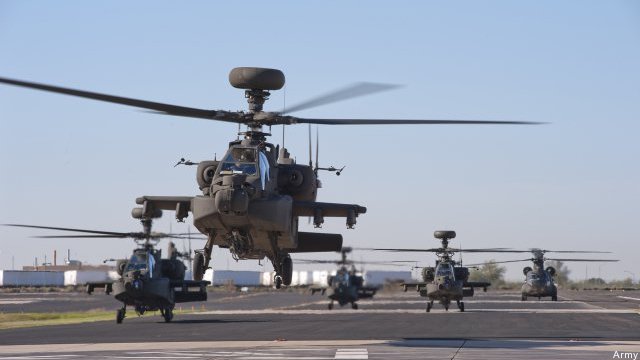
UPDATED: Retired Gen. Ham Adds Apache Cost Info At Friday breakfast
WASHINGTON: The congressionally chartered National Commission on the Future of the Army recommends splitting the difference between the regular Army and the National Guard in a bitterly polarizing dispute over AH-64 Apache attack helicopters. That’s the most politically high-profile recommendation out of dozens, many of them aimed at strengthening Army deterrence against North Korea and Russia.
[Click here to read Pentagon and other reactions to the report]
The Apache compromise, however, would cost hundreds of millions more than current Army budgets allow, although the commission proposed offsetting cuts to UH-60 Black Hawk helicopters. The commission also urges the Army to retain 11 Combat Aviation Brigades, one of them permanently based in South Korea, rather than cut down to 10 and rotate units through Korea as is the current plan. Again, this would add to Army costs. The permanent basing in Korea would cost just $40 million annually, but retaining the 11th CAB would add $450 million a year in operating costs plus $1.9 billion to buy 48 new Apaches.
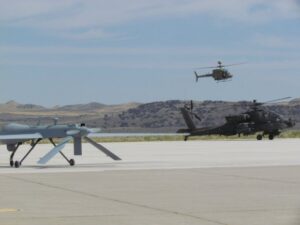
Army Grey Eagle drone (left) and AH-64 Apache (right)
Why would the Army would need to buy more Apaches just to keep the 11 CABs it already has? The root cause is the decision to retire the venerable OH-58 Kiowa scout without buying a new scout helicopter to replace it, which the Army couldn’t afford. Instead, Apaches — augmented by Grey Eagle drones — will take on the Kiowa’s scout role as well as their original attack mission. That means the Army needs more Apaches to keep even its existing force structure.
So, as the central piece of a complex cost-cutting plan called the Aviation Restructure Initiative (ARI), Army leadership had proposed consolidating all Apaches in 20 active-duty battalions, leaving zero gunships in the Guard. The National Guard Bureau, an independent Pentagon entity, had countered with a plan to keep all six existing Guard Apache battalions. The Army Commission’s final report, out today, offers a compromise that slightly favors the Guard: 20 active-duty battalions of 24 Apaches each and four Guard battalions of 18 gunships each.
The smaller Guard battalions are a pure cost-cutting expedient: [UPDATE: giving them a full complement of 24 helicopters would cost “about a $1 billion,” said Ham at a Defense Writers’ Group breakfast Friday morning.]
But still, “you need 24 to fight so what you would do during mobilization is borrow helicopters from another unit” that wasn’t going to war, said commissioner Bob Hale, the former Pentagon comptroller, in a public briefing this afternoon. [UPDATE: The Guard does such “cross-leveling” routinely and will make it work, Hale emphasized at Friday’s breakfast.]
Even with budget-sized battalions, filling out this force would require upgrading an additional 24 D-model Apaches to the latest AH-64E Guardian variant for roughly $420 million. Having a larger Apache fleet than the ARI envisioned would also add about $165 million a year to Army operating costs.
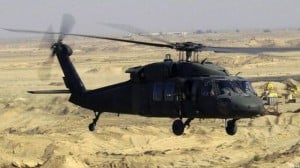
UH-60 Black Hawk
To offset these costs, the commission would halve the number of new UH-60 Black Hawk battalions being added to the Guard from four to two, and it would reduce the Black Hawk buy by five to 10 aircraft each year. The UH-60 utility helicopters are in high demand for both federal missions abroad and for state disaster relief at home, the commission report acknowledges, but the Apaches are even more critical.
“[UH-60s] are very important to the Army’s warfighting capability but it is a big fleet so you could reduce slightly the size of that,” said Hale. That has its disadvantages, but “we felt they were outweighed by the advantages of keeping some apaches in the guard.”
Overall, “the commission option provides more wartime capacity than the ARI; it also provides some surge capacity [i.e. Guard units to mobilize when needed; it does add to costs,” Hale said. The commission’s aim is not to reject ARI but to “modify” it, he said: “We kept most of it.”
The modification to ARI — add Apaches, subtract Black Hawks, and make a few other tweaks around the edges — is actually cost-neutral, Hale told reporters after the public briefing. But when you add all the other improvements the commission wants to make to Army aviation — especially the 11th CAB — and other areas, “you’ve got a big bill,” he said. “We are candid in the report in saying, if you’re going to do all of those, and especially if you’re also going to fix short-range air defense and missile defense and some of the shortfalls in combat enablers, the Army’s gonna need more money.”
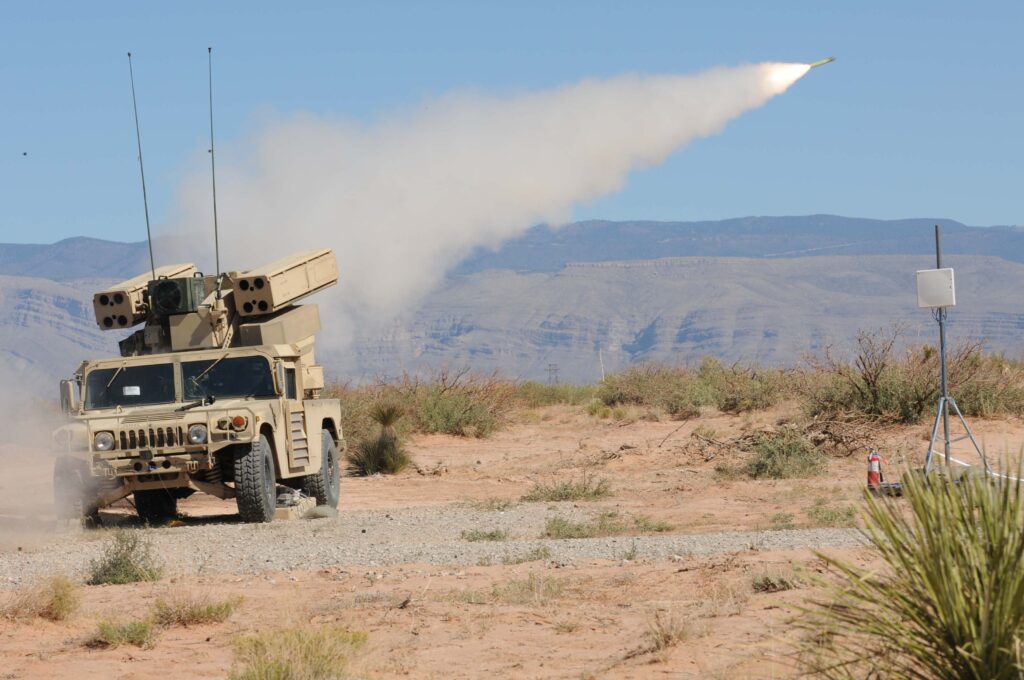
An Avenger Humvee launches a Stinger anti-aircraft missile.
Beyond the Helicopters: Rise of the Drones
Beyond the shortfalls in Army aviation, the commission found a major shortfall in short-range air defense — that is, the ability of Army units to shoot enemy aircraft out of the sky. It’s not just ever-improving Russian and Chinese aircraft: It’s the drones the Russians use to spot for artillery.
“Yes, of course, the Russian threat is crucial,” said commissioner Kathleen Hicks, but equally important is that Russia and China will sell their technologies, and others can replicate them with off-the-shelf drones, either as cheap scouts or flying IEDs. So, she said, “whether or not there is a specific Russian challenge today, we should be anticipating that capability will spread.”
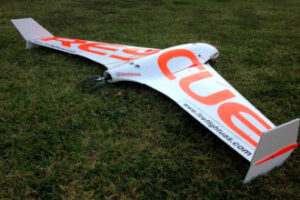
Flanker drone
“I can go to Best Buy right now and buy a UAV [Unmanned Aerial Vehicle], and I can probably arm that thing,” said fellow commissioner James Thurman, a retired Army general. Such retail air attack is a real threat to Army ground forces.
That was not what Army leaders planned for when they designed the current Army, noted the commission chairman, retired Gen. Carter Ham. “For all kinds of understandable reasons there are today in the regular Army no short ranged air defense battalions. They all exist in the reserve component,” he said. What’s more, since 9/11, most of the Guard air defense units have been tied up defending the DC region — “we live under that umbrella right here,” he said — which leaves little to deploy abroad.
While aviation and short-range air defense were the two top shortfalls, they were hardly the only ones the commission identified. “Other capabilities with significant shortfalls include tactical mobility; missile defense; chemical, biological, radiological, and nuclear (CBRN); field artillery; fuel distribution; water purification; watercraft; and military police,” the report said. The commission would also return an armored brigade to Europe to deter the Russians, permanently basing the brigade there rather than rotating units through.
If the Army cannot increase its force structure over the current 980,000 target (450,000 active, 335,000 Guard, and 195,000 Reserve), which the commission and Army leaders agree is the absolute minimum to do the mission, the commission recommends dissolving two active-duty infantry brigades and using their personnel to fill the gaps in aviation, air defense, and other areas, including armor.
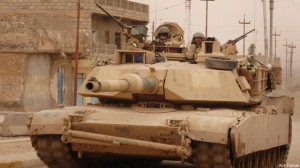
An M1 Abrams tank.
[UPDATE: “That’s a terrible decision to have to make,” Ham said at the Friday breakfast, “[but] in the modeling that we did, infantry brigade combat teams –while very, very important — were among the less stressed capabilities that the Army possesses.” In other words, the shortfall in infantry is much less than in other types of troops.
[UPDATE: Those shortfalls include armored brigades, especially in face of Russian mechanized forces in Europe. “We looked very hard at the wartime peak demand for BCTs [brigade combat teams] of all types, all kinds of units [i.e. not just BCTs] and at the enduring ‘peacetime’ – I use that with air quotes — demand,” Hicks said at the breakfast. “That analysis that we did indicated a definite lack of armor so we recommend that there be an increase.”
[UPDATE: Guard infantry, which is arguably underutilized, can make up for dissolving two regular Army infantry brigades, Hicks said. “This frees up a lot of manpower billets, [about] 8,600,” to man aviation, air defense, and other undermanned specialities. But, she cautioned, since lightly equipped infantry brigades are much cheaper per soldier than armor or aviation, “what you can’t do is offset the costs.”]

Army graphic
Overall, “the Commission finds that the nation can maintain a force of 980,000 soldiers, along with reasonable levels of readiness and modernization, only with budgets at levels at least equal to those proposed in the President’s request for fiscal year 2016,” the report said. “Sequester-level funding established by the Budget Control Act of 2011, as amended, will not be enough.”
“There’s reason to be cautiously optimistic we’ll see some kind of budget deal — everybody wants to get rid of this thing — with the new administration; it’s certainly not going to happen next year,” Hale told reporters, emphasizing he was speaking for himself, not for the commission, in making this forecast. “I don’t think it’s naïve to think there’ll be some added funds for the Army and the other services. What we’ve got right now is a poor excuse for peace. and usually when threats are high,” budgets tend to go up too.
Subscribe to our newsletter
Promotions, new products and sales. Directly to your inbox.
